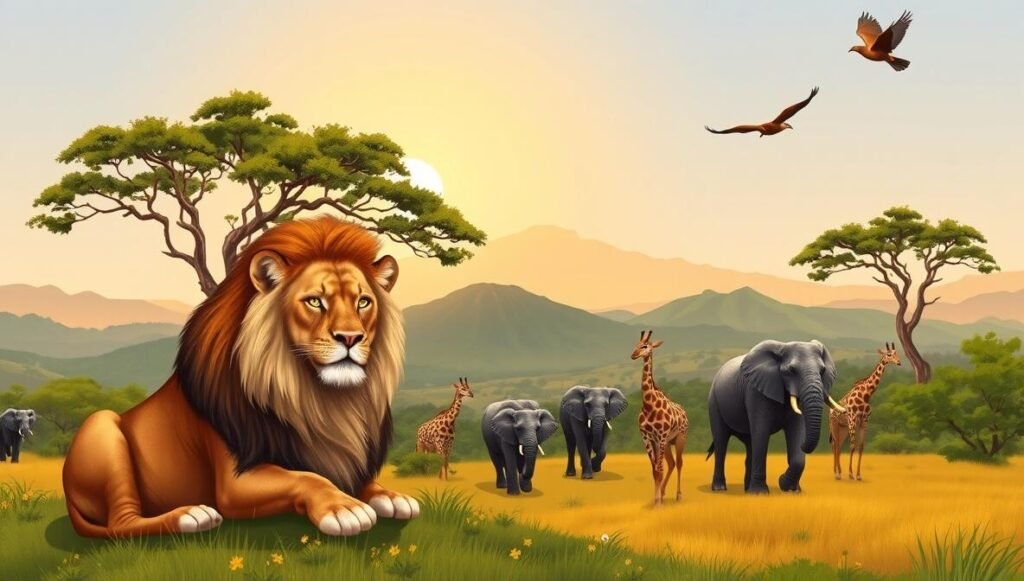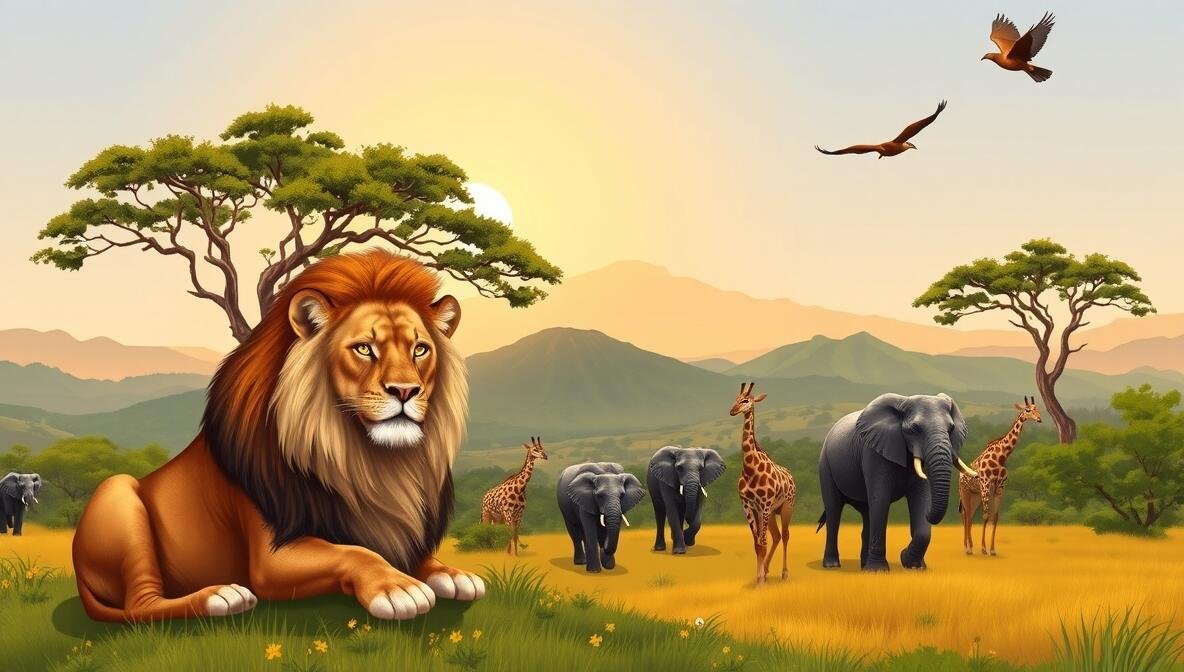Tanzania, with its iconic savannahs and extraordinary biodiversity, is a dream destination for wildlife enthusiasts. Known as the land of safaris, this East African gem offers visitors unparalleled opportunities to witness nature in its raw and majestic form. Home to world-renowned national parks, diverse ecosystems, and the Great Migration, Tanzania stands as one of the best places to see wildlife in Tanzania.
Whether you’re catching a glimpse of the elusive leopard in the Serengeti or marveling at pink flamingos on the shores of Lake Natron, Tanzania promises unforgettable sights at every turn.

Why Tanzania Is the Best Place to See Wildlife
Tanzania’s global reputation as a wildlife haven stems from its extensive array of natural habitats, ranging from savannahs and wetlands to mountains and coastlines. Approximately one-third of the country is protected, with numerous national parks and game reserves ensuring conservation efforts that support healthy and thriving wildlife populations.
The Serengeti ecosystem, for instance, is home to the Great Migration, a natural spectacle involving millions of wildebeest, zebras, and gazelles. Additionally, Tanzania boasts Ngorongoro Conservation Area, a UNESCO World Heritage Site recognized for its unique crater ecosystem and staggering concentration of animals, including the Big Five.
Tanzania’s ecological diversity also stretches beyond the plains. Coastal regions like Mafia Island offer vibrant marine ecosystems, while the Usambara Mountains showcase lush and biodiverse rainforests. Strong conservation initiatives and eco-tourism programs further highlight Tanzania’s commitment to preserving its wildlife heritage for generations to come.
Top Wildlife Spots in Tanzania
1. Serengeti National Park
The Serengeti is globally recognized as a premier safari destination. It’s here that the Great Migration occurs, with over two million animals making a perilous trek in search of fresh grazing. Alongside this wonder, expect to see lions stalking prey, hyenas scavenging, and herds of elephants roaming the plains. Birdwatchers will also delight in spotting species like secretary birds and vultures.
2. Ngorongoro Crater
This massive volcanic caldera is home to an astonishing density of wildlife, earning its reputation as a natural wonder. The crater’s floor is teeming with rhinos, lions, elephants, and buffalo. Flamingos flock to Lake Magadi, which lies within the crater, creating a mesmerizing pink expanse during their migrations.
3. Ruaha National Park
Often overlooked due to its remote location, Ruaha offers a more intimate wildlife experience. Its landscape features rugged baobab-studded terrain, home to vast elephant herds, lions, leopards, and African wild dogs. Ruaha is also known for its impressive diversity of birds, with over 570 species recorded.
4. Selous Game Reserve (Nyerere National Park)
One of Africa’s largest protected areas, Selous combines rivers, lakes, and savannahs to create the perfect environment for crocodiles, hippos, and waterfowl. Boat safaris along the Rufiji River provide unique wildlife viewing opportunities, unlike traditional land safaris.
5. Lake Manyara National Park
Bordered by the Rift Valley, Lake Manyara is known for its tree-climbing lions and sizable populations of flamingos. The shallow soda lake attracts elephants, hippos, and monkeys, while also serving as a sanctuary for over 400 bird species.
Best Time of Year to Spot Wildlife in Tanzania
The best times for wildlife viewing in Tanzania depend on the region and desired experiences:
- Dry Season (June to October): This is ideal for spotting animals concentrated around water sources. Parks like Serengeti and Ngorongoro are at their peak for game viewing.
- Great Migration Crossing (July to September): Witness the iconic river crossings of the Mara River, where wildebeest and zebras brave crocodiles.
- Wet Season (November to May): The landscape is lush and green, offering fantastic opportunities for birdwatching as migratory species settle in. Additionally, calving season (January to February) brings baby animals and increased predator activity.
Animals You Can Expect to See in Tanzania
Tanzania’s wildlife roster includes:
- Mammals: Lions, leopards, cheetahs, wildebeest, giraffes, elephants, hippos, hyenas, and zebras.
- Birds: Flamingos, crowned cranes, fish eagles, vultures, and hornbills.
- Reptiles: Nile crocodiles, monitor lizards, and pythons.
- Marine Life (off the coast): Whale sharks, dolphins, and sea turtles.
Tanzania’s varied environments ensure sightings of diverse and awe-inspiring species throughout the year.
Tips for Safe & Ethical Wildlife Viewing
To ensure every wildlife encounter is respectful and minimizes harm, follow these tips:
- Stay Quiet and Observant: Keep noise to a minimum to avoid startling animals.
- Don’t Feed Wildlife: Offering food can disrupt animals’ diets and influence harmful behaviors.
- Choose Responsible Tour Operators: Look for certified operators committed to eco-friendly practices.
- Follow Park Rules: Stay in designated zones to protect fragile ecosystems.
- Avoid Littering: Leave no waste to maintain clean and safe habitats.
Wildlife Photography Tips
Enhance your safari memories with these photography tips:
- Pack the Right Gear: A zoom lens (200mm or more) is crucial for close-up shots.
- Focus on Early Morning or Late Afternoon: These hours provide soft lighting and active wildlife.
- Use Stable Support: Bring a monopod or a beanbag for steady shots, particularly in vehicles.
- Experiment With Angles: Capture both wide shots of landscapes and close-ups of animal behavior.
- Be Patient: The best shots come from waiting and watching for unique interactions.
How to Get to Tanzania’s Top Wildlife Destinations
Reaching Tanzania is convenient via its main international airports:
- Julius Nyerere International Airport (Dar es Salaam): Ideal for visits to southern parks like Selous.
- Kilimanjaro International Airport (Arusha): A gateway for the Serengeti, Ngorongoro, and Lake Manyara.
- Domestic Flights: Local charters connect routes seamlessly, saving travel time.
Where to Stay Nearby
Stay close to nature with options catering to all budgets:
- Budget: Eileen’s Trees Inn, a cozy lodge near Ngorongoro.
- Mid-Range: Rhotia Valley Lodge, offering charming accommodations close to Lake Manyara.
- Luxury: Four Seasons Serengeti, with elegant lodgings overlooking watering holes teeming with wildlife.
Affiliate suggestion:
Discover exclusive offers on safari lodges and eco-accommodations here [#].
Nearby Attractions or Activities
Add variety to your Tanzanian adventure by exploring these highlights:
- Mount Kilimanjaro: Scale Africa’s tallest peak for awe-inspiring views.
- Zanzibar: Relax on white-sand beaches or enjoy marine wildlife expeditions.
- Olduvai Gorge: Visit this archaeological site, considered the “Cradle of Humankind.”
Conclusion
Tanzania offers a wildlife experience that’s truly unmatched. Its iconic parks, conservation ethos, and rich biodiversity make it one of the best places to see wildlife in Tanzania. Whether you’re chasing the Great Migration or exploring off-the-beaten-path reserves, Tanzania promises encounters that will stay etched in your memory forever.
Start planning your safari adventure today to discover all the magic Tanzania’s wildlife has to offer.
When is the best time to visit Tanzania for a safari?
The dry season (June to October) is perfect for game viewing as animals congregate near water.
Can I witness the Great Migration in Tanzania?
Yes, the Serengeti hosts this incredible event, particularly from July to September for river crossings.
Do I need a guide for game parks?
Guided tours enhance the experience, offering expert knowledge and safety.
What should I pack for a safari in Tanzania?
Essentials include sturdy shoes, sun protection, binoculars, and a good camera.
Are wildlife tours family-friendly?
Absolutely! Many lodges and safaris cater to families with kid-friendly activities.

Anamika is a passionate writer for Eco365Store.com, specializing in topics that inspire a cleaner, greener world. With expertise in home cleaning, recycling, and eco-friendly solutions, she crafts engaging and informative articles that help readers adopt sustainable practices in their daily lives.

